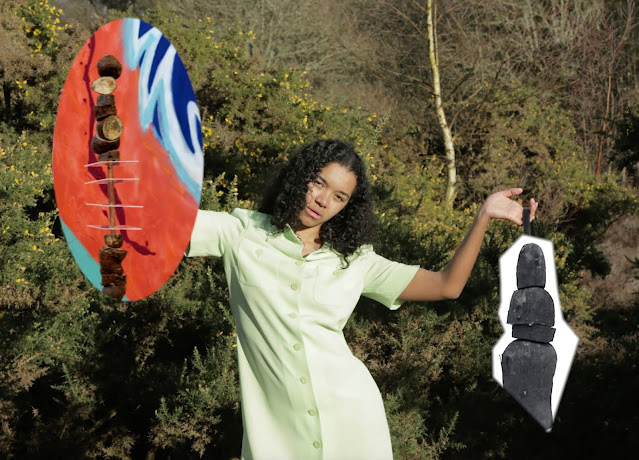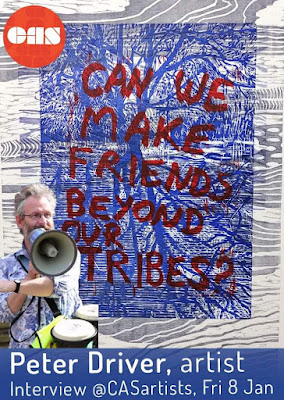I put four photos into an exhibition curated by Cally Trench. Only The Sunny Hours; contemporary photography with a KODAK Brownie 127. At OpenHand OpenSpace, Reading, 20-24 June 2018.
I'm very grateful to Cally for including me in the project. I haven’t often used
photography in my practice and it has been an interesting experiment for
me.
 |
| Greenham Common: towards the control tower - Dartford Warbler [Peter Driver 2018] |
My four photos were made on Greenham Common. I am fascinated by the place, its history and what it has become. Because of its history and particularly the
activism of the Women’s Peace Camp it has been used as subject matter by a
number of contemporary artists over the last twenty years or more [for instance Margaret Harrison, and Jane and
Louise Wilson's ‘Gamma’]. My work involves
making drawings, prints and photographs on the site. And thanks to Cally I have discovered
something about the quality of the photos from a Brownie 127 that adds to the poetic
sensibility of the work.
People of my generation and older will recall that during
the Cold War, in the 1980s, when NATO powers were locked in a nuclear arms race
with the Soviet Union, the British Government agreed to site United States
tactical inter-continental nuclear weapons in Britain. From 1983, over ninety
ground-launched Cruise Missiles, with nuclear warheads, were sited at RAF
Greenham Common, which was used by the United States Air Force.
Between 1981 and 2000 a Women’s Peace Camp was maintained at
Greenham Common by a changing cast of many thousands of women. They were
protesting against siting nuclear missiles on the base. Some of the women camped around the perimeter
long-term (the longest-serving protesters camped there for nineteen years);
others visited as often as they could to offer support.
Throughout the duration of the peace camp women were routinely evicted, assaulted by police and military, abused by passers-by, arrested, imprisoned, and vilified in the press. Undeterred, they maintained their protest. In December 1982, 30,000 women came together to surround the entire base in a hand-holding chain entitled ‘embrace the base’. The women staged a continuous range of non-violent actions, chaining themselves to the fences, blockading the entrances, cutting through the fences and invading the silos where the missiles were stored.
 |
| Greenham Common: missile bunkers - Ring Ouzel [Peter Driver 2018] |
There are many documentary sources for the study of the
Greenham phenomenon, including Sasha Roseneil’s sociological study, Disarming
Patriarchy: feminism and political action at Greenham (Open University, 1995), and the film
‘Carry Greenham Home’, by Beeban Kidron and Amanda Richardson.
Many people, probably the majority of people at the time, disagreed
with their stance and certainly disapproved of their tactics. But, love them or loathe them, the Women’s
Peace Camp stands as one of the most significant acts of durational dissent in
British history. Their achievement was
to bring radical feminist direct action and civil disobedience into the public
discourse. Greenham left a global legacy of activism, inspiring people and
especially women, worldwide to new forms of critical engagement, protest and
direct action. The Peace Camp and its repertoire of creative forms of resistance became the inspiration for later
campaigns - including the Twyford Down and Newbury Bypass environmental protests, and the
Occupy Movement.
The Cruise missiles were eventually removed in 1991 as part
of arms reduction agreements between Gorbachev and the West, and the base was
decommissioned. It isn't possible to
demonstrate any causal link between the protests and the decommissioning but with hindsight, public opinion about nuclear weapons has changed and has been informed by the courageous protests at Greenham.
 |
| Greenham Common: remnant of the fence - Woodlark [Peter Driver 2018] |
The commons were officially re-opened to the public in 2000. The two-mile length of concrete runway was broken up and the huge site has now largely reverted to natural heathland habitat. It provides a haven for wildlife alongside cyclists, joggers, grazing cattle, and dog-walkers. Several endangered bird species have returned to nest on the site.
About a dozen pairs of Woodlark are now present. Wheatear and Ring Ouzel stop-over on passage
to and from their upland breeding grounds. And for me, the most notable
returnee is the Dartford Warbler. A
species that was on the brink of extinction in Britain when I became a
birdwatcher in the late Sixties, at the age of eight.
By this time last year numbers of Dartford Warblers had
risen to over three thousand pairs in Britain, with eleven territories on the
Common – a massive success story.
Unfortunately, this year, the picture is different. The horrendous cold
snap, dubbed ‘The Beast from The East’ almost wiped out some local populations
of Dartford Warblers. The harsh weather
came right at the end of the winter when birds were on the brink of perishing
from starvation. Repeated surveys on
Greenham Common have found only one breeding pair this year. Personally I have seen one bird all
year. It’s a similar picture on the
Thames Basin Heaths on the Berkshire/Surrey border. This is a major set-back from which there is
just a glimmer of hope for another slow recovery.
So my work holds together these two themes of the social-historical
significance of the site and its current ecological importance. I see the act of birdwatching and drawing on
the site as a way of responding to what it once was, and now is.
I think it's important to recognise a risk for my work that I
could be co-opting the history and the activism of those fierce and defiant women
in an effort to make my work seem more radical or interesting, by
association. But the urgency and power
of direct action will always be more discomforting and demanding of a response
than any artwork in a gallery.
My work alludes to the traces and memories of things that
are no longer there and the fact of my presence to apprehend that absence. There is a kind of poetic dissonance created
between the different times and their different uses of the site.
The work also carries my memory of living under the threat
of nuclear annihilation I grew up in the ground-zero zone around RAF Mildenhall
in East Anglia, and the nuclear threat was as an ever-present, but generally
unacknowledged backdrop to my childhood and adolescence. Those memories remain part of my relationship
with Greenham Common. In a way, this makes the act of birding on the site a celebration
of human survival just as much as it celebrates the return of the Dartford
Warbler. I am interested in presenting the
social history, in a tangential rather than didactic way, reflecting on it,
inviting others to do the same and in their own ways, to consider what
implications there might be for their own lives and comforts.
 |
| Greenham Common: fire plane - Wheatear [Peter Driver 2018] |
I have great respect for the Women’s Peace Camp movement that stood opposed to an unassailable global power at Greenham. I recognise my work's inadequacy
to address such issues, or to affect any change. But I hope it can point towards what can be achieved by people united in common
cause and collective action. If all
else fails it could just highlight the changing fortunes of the bird populations, as
a gesture of helplessness.
If art is able to achieve anything in the world then I
hope the work can operate as a small beacon for the forms of resistance that
we're all going to need in the impending future.


































